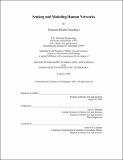Sensing and modeling human networks
Author(s)
Choudhury, Tanzeem Khalid, 1975-
DownloadFull printable version (28.78Mb)
Other Contributors
Massachusetts Institute of Technology. Dept. of Architecture. Program in Media Arts and Sciences.
Advisor
Alex P. Pentland.
Terms of use
Metadata
Show full item recordAbstract
Knowledge of how groups of people interact is important in many disciplines, e.g. organizational behavior, social network analysis, knowledge management and ubiquitous computing. Existing studies of social network interactions have either been restricted to online communities, where unambiguous measurements about how people interact can be obtained (available from chat and email logs), or have been forced to rely on questionnaires, surveys or diaries to get data on face-to-face interactions between people. The aim of this thesis is to automatically model face-to-face interactions within a community. The first challenge was to collect rich and unbiased sensor data of natural interactions. The "sociometer", a specially designed wearable sensor package, was built to address this problem by unobtrusively measuring face-to-face interactions between people. Using the sociometers, 1518 hours of wearable sensor data from 23 individuals was collected over a two-week period (66 hours per person). This thesis develops a computational framework for learning the interaction structure and dynamics automatically from the sociometer data. Low-level sensor data are transformed into measures that can be used to learn socially relevant aspects of people's interactions - e.g. identifying when people are talking and whom they are talking to. The network structure is learned from the patterns of communication among people. The dynamics of a person's interactions, and how one person's dynamics affects the other's style of interaction are also modeled. Finally, a person's style of interaction is related to the person's role within the network. The algorithms are evaluated by comparing the output against hand-labeled and survey data.
Description
Thesis (Ph. D.)--Massachusetts Institute of Technology, School of Architecture and Planning, Program in Media Arts and Sciences, 2004. Includes bibliographical references (p. 101-105). This electronic version was submitted by the student author. The certified thesis is available in the Institute Archives and Special Collections.
Date issued
2004Department
Program in Media Arts and Sciences (Massachusetts Institute of Technology)Publisher
Massachusetts Institute of Technology
Keywords
Architecture. Program in Media Arts and Sciences.